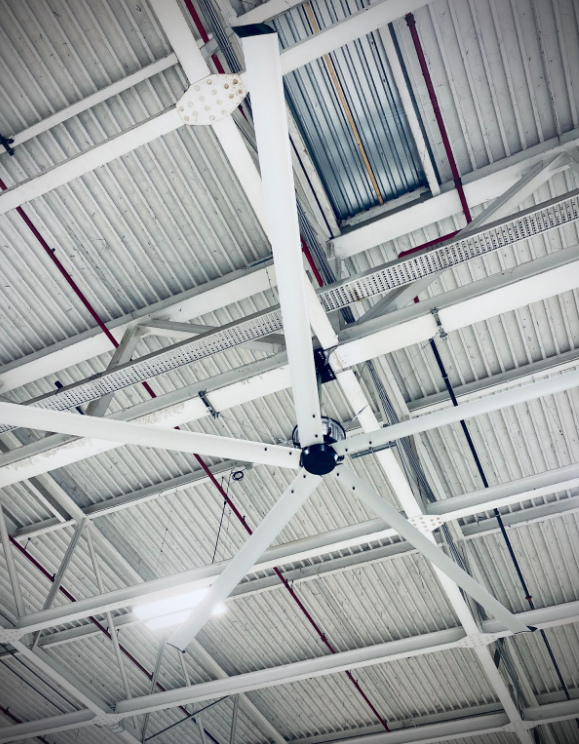
In the context of global business and industries, two important factors are cost control and productivity enhancement. High-Volume, Low-Speed (HVLS) fans have become a preferred way of managing climate change and operating the energy economy. However, another crucial factor that can interest decision-makers is the time it takes for an HVLS fan to break even.
Understanding the Impact of HVLS Fans
Despite their slow rotational speeds, HVLS fans move a lot of air. Their main purpose is to efficiently move air around huge areas, which has a big impact on energy usage, thermal comfort, and air quality.
Given the possible initial investment associated with HVLS fans, it is crucial to evaluate the ROI carefully. The silver lining is that by greatly reducing heating and cooling costs, HVLS fans can generate a highly compelling rate of return.
The Major Benefits of HVLS Fans
- Energy Efficiency: By increasing air circulation, which results in more constant temperatures across a facility, HVLS fans help to lessen the dependency on HVAC systems. Energy savings from this might be significant.
- Greater Comfort: HVLS fans distribute air uniformly across the facility and eliminate hot and cold zones, providing the comfort occupants of large structures such as gyms, factories, and warehouses need.
- Moisture Management: Correct ventilation enhances the control of relative humidity, ensuring restricted growth of mold and mildew and protecting the structure of the premises and stored products where necessary.
- Better Indoor Air Quality: Since they facilitate air movement, HVLS fans may help in minimizing the concentration of airborne contaminants and enhance overall IAQ.
Factors Affecting The ROI
How soon your HVLS fans will pay for themselves in full depends on a number of important factors, including:
- Facility Size: As there is more air volume to circulate in larger, higher-ceilinged spaces, HVLS fans typically result in greater cost savings.
- Existing HVAC Efficiency: By lightening the burden, HVLS fans can make a greater difference if your existing HVAC system is older or less effective.
- Efficiency of Your Current HVAC System: HVLS fans can make a greater difference by lessening the strain if your HVAC system is older or less effective.
- Geographical Conditions: Facilities in areas with more extreme climates (hot summers, freezing winters) spend more money on heating and cooling, providing for higher potential savings.
- Operating Hours: The more hours a day or week that your facility is open, the quicker the HVAC runtimes saved by HVLS fans will offset their cost.
- Utility Rates: The savings with HVLS fans increase in proportion to local energy prices.
ROI Calculation for HVLS Fans
There are multiple components that contribute to the overall cost savings and payback period when analyzing the ROI of HVLS fans. These components include:
- Energy Savings: A return on investment’s largest component is often its reduction in energy costs. Improved air circulation from HVLS fans reduces the load on HVAC systems. According to industry estimates, buildings can save 20–30% on energy costs associated with HVAC systems.
- Lower Maintenance Costs: In comparison to conventional HVAC systems, HVLS fans usually require less maintenance. They are less likely to fail since they have fewer moving parts. Over time, this may result in cheaper maintenance expenses.
- Better Productivity: Increased environmental comfort and better air quality can decrease absenteeism among personnel in industrial settings where temperature control is fundamental.
- Extended Equipment Life: HVLS fans can help HVAC systems and other climate control equipment last longer and save money by doing so. This is because they put less stress on these systems.
ROI Estimate Examples
To get a clearer picture of a realistic HVLS fan payback period, let’s look at some example scenarios:
Scenario 1:
30,000 sq ft Warehouse
Install Cost of 4 HVLS Fans: $40,000
Location: St. Louis, MO
Utility Rates: $0.10/kWh
Operating Hours: 3,000 hours/year
Previous Annual HVAC Cost: $25,000
Projected Annual Savings from HVLS: 30% = $7,500
ROI Period: $40,000 install cost / $7,500 annual savings = 5.3 years
Scenario 2:
120,000 sq ft Manufacturing Plant
Install Cost of 14 HVLS Fans: $120,000
Location: Phoenix, AZ
Utility Rates: $0.12/kWh
Operating Hours: 6,000 hours/year
Previous Annual HVAC Cost: $180,000
Projected Annual Savings from HVLS: 35% = $63,000
ROI Period: $120,000 install cost / $63,000 annual savings = 1.9 years
As you can see, various factors, like facility size, environment, operating hours, and energy prices, can substantially impact the ROI period. A warehouse in a milder environment takes over five years to pay for itself, whereas a manufacturing factory in the hotter Phoenix climate with extended operational hours gets a payback in less than two years.
Conclusion
The duration of the return on investment for HVLS fans ultimately depends greatly on each facility’s unique characteristics. Larger facilities with longer operation hours and higher cooling/heating costs will pay for themselves the quickest—possibly in as little as 1-2 years.
However, HVLS fans can still provide an alluring return on investment in the range of three to six years, in addition to the added advantages of improved comfort, temperature distribution, and air quality in smaller areas or milder climes.
Ready to invest in HVLS fans and see a return on your investment? Get in touch with Refresh Fans right now. As the leading experts in HVLS fan solutions, we will ensure that you receive the optimal system for maximum energy savings and comfort.